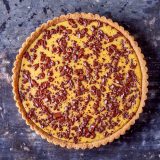Rose Carrarini, silver-haired and compactly British, stands in the original Rose Bakery on 46 Rue des Martyrs in the 9th arrondissement, not far from what used to be one of the seediest Parisian neighborhoods, along with Place Pigalle and the Moulin Rouge. Her small storefront eatery is a transformative combination of English tearoom and French café—cooks and bakers crammed into tiny spaces stacked with boxed and bagged market ingredients, the customers ordering simple plates of vegetables, a quiche or soup simply to get to dessert: tidy but richly flavored cakes and tarts flavored with caramel, coconut, lime or pistachio, to name a few.
My go-to dessert—I've been known to order two in one sitting—is the chocolate, orange and ricotta tart.
Before we set out to adapt this filling, however, we needed to find a suitable partner in a crust, one that was humble but could share culinary honors with the filling.
That search took us to the pastry case of Vancouver's Beaucoup Bakery. There, we found a sunny yellow lemon-yuzu tart with the honest-but-special crust we were looking for: a crisp, slightly crunchy almond meal affair that had us at first bite. The copper-colored crust is a riff on classic French pâte sucrée, a sweet, sturdy dough that bakes up with the crumbly texture of a cookie. (In fact, the late, legendary pastry chef Gaston Lenôtre called for pulverized almonds in his pâte sucrée recipe.)
Beaucoup's founder and former owner Jackie Kai Ellis used the dough as a platform for all of the bakery's tarts, sweet and savory. It's a recipe she learned in pastry school in France, where the art of tarts was drilled into the designer-turned-baker's mind. While she can speak at length about the precision required for making a proper tart—perfectly even shells, 90 degree angles and uniformly colored crusts are but a few factors—when it comes to this crust, “It's quite easy,” she says.
Flour, almond meal, a little sugar, quite a bit of butter and some eggs come together in a mixer to make a very short, but very stable dough. “The glutens are quite loose because of all the fat content and sugar content in the almond,” Ellis says. And, thanks to the almond meal, the dough has a deeper flavor and crisper texture than traditional pâte sucrée.
At Milk Street, we began to develop a similar dough recipe using a 2:1 ratio of all-purpose and almond flours. We had to adjust the amount of butter, sugar and egg to get the right tender-firm balance. The result was a dough with great flavor and texture—and, to our delight, one that didn't shrink or slump when blind baked.
At Beaucoup, the pastry chefs roll out the dough with a machine called a sheeter. Ellis says you can do it by hand, as long as the dough is very cold beforehand. We liked an even simpler approach: Rather than roll out the crust—which can be a challenge with nut-based doughs—we crumbled the just-made dough directly into the tart pan, then pressed it into an even layer with a measuring cup. We didn't even need pie weights.
A brief stay in the freezer firmed the dough, and a long, low blind bake at 300°F browned it thoroughly. The blind bake develops the crust's nutty flavor and results in a super-crisp crust.
Next, we went back to the Rose Bakery filling: Carrarini's decadent cheesecake-style filling, made with ricotta, cream, orange zest and dark chocolate, all bound together with a tablespoon of flour. The flavors almost mimic those of cannoli filling—a likeness we built on with the addition of some cinnamon. We also lightened our version by omitting cream as well as the flour, and we reduced the amount of chocolate, allowing the ricotta and orange to come through more clearly.
Finally, we experimented with the best way to add chocolate to the tart: finely ground, pulsed into the filling, in large chunks and melted in single layer. We settled on chopping semisweet chocolate, which preserved the crisp-textured crust of this creamy, patisserie-worthy tart.




